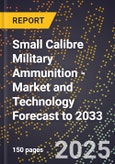Market Forecast by Region and Ammunition Calibre. Country Analysis, Market and Technology Overview Including Critical Raw Materials, Opportunity Analysis, and Leading Company Profiles.
The small calibre military ammunition market is entering a multi-year upcycle. Elevated consumption linked to the war in Ukraine and the resetting of NATO readiness targets have shifted demand from peacetime “sustain” levels to durable, programme-based buys. Europe currently leads the expansion, with the United States remaining a strong, steady segment - together underpinning a robust pipeline for qualified suppliers and investors.
Supply remains the gating factor. Bottlenecks in primers, energetics (e.g., nitrocellulose), brass, and skilled labour are constraining output, while new case-draw, primer, bullet-assembly and LAP lines typically require one to three years to reach stable, qualified production. For businesses prepared to act, this imbalance creates attractive pricing, backlog visibility, and an opportunity to lock in long-term customer relationships.
Winning strategies centre on scalable resilience: multi-year framework agreements and predictable training-load volumes to keep lines warm; flexible tooling to swing efficiently across 5.56/7.62/9/.50 and 6.8×51 families; vertical integration or long-term offtakes in primers, powders and brass; and productivity levers such as automation, yield management and OEE. Interoperability and NATO/STANAG conformance remain essential differentiators for exportability and speed to qualification.
Market structure will stay fragmented as nations pursue ammunition autonomy, opening room for partnerships, JVs, and targeted M&A. At the same time, trade frictions and tariff regimes raise input costs and complicate cross-border sourcing - favouring operators that diversify suppliers, regionalise footprints, dual-qualify materials and secure long-dated energetics and energy contracts. For business leaders, the message is clear: the cycle is strong, capacity is scarce, and early movers that build resilient, compliant, cost-competitive platforms will set the pace.
This study examines procurement pathways for small-calibre military ammunition and assesses how the war in Ukraine is reshaping the market. The scale and value of the opportunity favour both new entrants and well-established manufacturers seeking to expand share. Even if the conflict ends in the near term, enduring security requirements and stockpile replenishment will sustain robust demand for years to come.
The study provides a model of the market size, in-depth insights procurement opportunities, mapping out the scope, scale, and timelines of opportunities worldwide. It also offers a solid understanding of the current situation in the small calibre military ammunition business landscape and what should be expected for the future.
Covered in this Study:
- Overview: A strong insight of the Small Military Ammunition market in the military market during 2025-2033, including highlights of the demand drivers, trends, and challenges. It also provides a snapshot of the spending with respect to regions as well as segments and sheds light on the emergence of new technologies.
- Market Dynamics: Snapshots into the technological developments in the small calibre military ammunition market. It also analyses the market landscape in key regions, how that is shaped by the war in Ukraine and the political and regulatory efforts undertaken to address a series of issues.
- Segment Analysis: Insights into the various calibres, end-use and regions from a segmental perspective and a detailed analysis of factors influencing the market for each segment.
- Regional Analysis: Insights into the systems market from a regional perspective and a detailed analysis of factors influencing the market for each region.
- Competitive Landscape Analysis: Analysis of the competitive landscape of this industry. It provides an overview of key companies, together with insights such as key alliances, strategic initiatives, and a SWOT analysis.
Market Segmentation
The market is segmented by Region and Calibre of the ammunition.
Region:
- North America
- Europe
- Asia Pacific
- Middle East & Africa
- Latin America
Calibres:
- 5.45mm
- 5.56mm
- 5.7mm
- 6.5mm
- 6.8mm
- 7.62mm
- 8.6mm (.338)
- 9mm
- 0.45APC (11.43mm)
- 12.7mm (.50 cal.)
Reasons to Buy:
- This report provides a global view of efforts to scale small-calibre military ammunition production, both to meet Ukraine’s wartime consumption and to replenish national stockpiles.
- It identifies and rigorously analyses the forces reshaping the market, including policy decisions, cross-industry collaborations, supply-chain redesign, and the availability of critical raw materials.
- It maps regional production profiles and assistance flows to Ukraine, clarifying how these dynamics are redirecting procurement worldwide.
- Finally, it highlights the principal opportunities and risks so decision-makers can act with confidence to grow their businesses.
Table of Contents
Companies Mentioned
- BAE Systems
- Day & Zimmermann
- DynCorp International
- Federal
- FN Browning
- FN Herstal
- General Dynamics - Ordnance & Tactical Systems
- General Dynamics - Ordnance & Tactical Systems Canada
- GGG (Giraite Ginluotes Gamykla)
- JPEO A&A - Joint Program Executive Office for Armaments & Ammunition
- Kalashnikov Group
- Kongsberg Defence & Aerospace AS
- Nammo
- Nibe Defence & Aerospace
- Nitrotol OÜ
- Olin/Winchester
- Patria Oy
- PGZ Mesko
- Remington
- Rheinmetall Expal
- Rostec
- SIA Ammunity
- Sig Sauer
- Speer
- Swedish Astor Group AB
- Techcrim
- The Kinetic Group
- Tula Ammo








